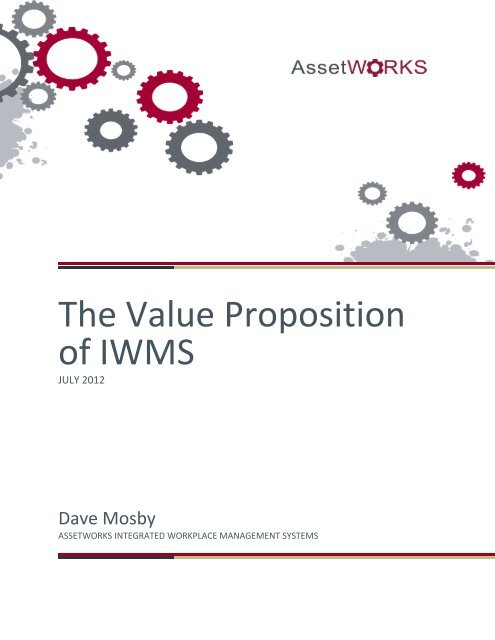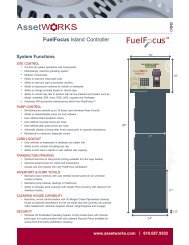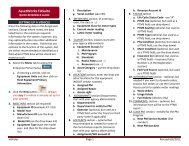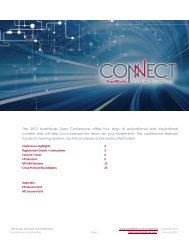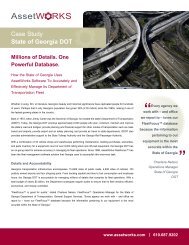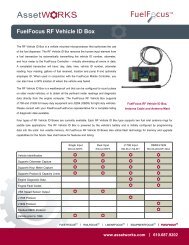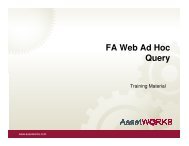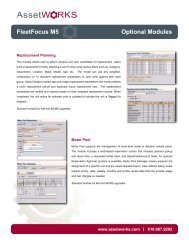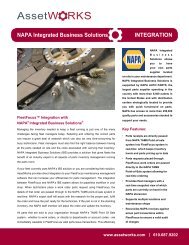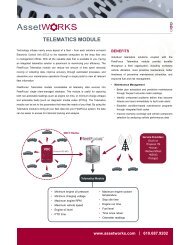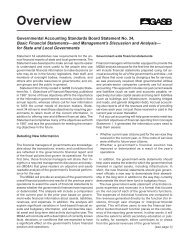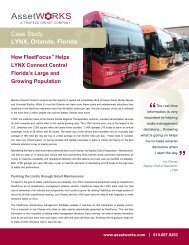The Value Proposition of IWMS - AssetWorks
The Value Proposition of IWMS - AssetWorks
The Value Proposition of IWMS - AssetWorks
You also want an ePaper? Increase the reach of your titles
YUMPU automatically turns print PDFs into web optimized ePapers that Google loves.
<strong>The</strong> <strong>Value</strong> <strong>Proposition</strong><br />
<strong>of</strong> <strong>IWMS</strong><br />
JULY 2012<br />
Dave Mosby<br />
ASSETWORKS INTEGRATED WORKPLACE MANAGEMENT SYSTEMS
Table <strong>of</strong> Contents<br />
Executive Summary 1<br />
SECTION 1: 2<br />
Purpose<br />
SECTION 2: 2<br />
Definitions<br />
SECTION 3: 2<br />
<strong>IWMS</strong> Provides a Systems View <strong>of</strong> Facilities<br />
Management<br />
SECTION 4: 3<br />
<strong>IWMS</strong> Decision-making: <strong>The</strong> <strong>Value</strong> Added<br />
Crisis management—real time information<br />
and knowledge<br />
Day to day operations—visibility,<br />
transparency and accountability<br />
Tactical planning—within the budget year<br />
Strategic planning—planning for future<br />
budgets<br />
SECTION 5: 5<br />
<strong>IWMS</strong> Dollar Savings/Cost Avoidance<br />
SECTION 6: 7<br />
Calculating the Return on Investment<br />
SECTION 7: 7<br />
Statewide Return on Investment Calculation<br />
(Table)<br />
SECTION 8: 7<br />
Conclusion<br />
About the Author 8<br />
Copyright © 2012 <strong>AssetWorks</strong> LLC. All rights reserved. All trademarks, trade names, service marks and logos referenced herein belong to their respective companies. This document is for your<br />
informational purposes only. To the extent permitted by applicable law, <strong>AssetWorks</strong> provides this document “As Is” without warranty <strong>of</strong> any kind, including, without limitation, any implied<br />
warranties <strong>of</strong> merchantability or fitness for a particular purpose, or non-infringement. In no event will <strong>AssetWorks</strong> be liable for any loss or damage, direct or indirect, from the use <strong>of</strong> this<br />
document, including, without limitation, lost pr<strong>of</strong>its, business interruption, goodwill or lost data, even if <strong>AssetWorks</strong> is expressly advised <strong>of</strong> such damages.
Executive Summary<br />
Challenge<br />
Between 2000 and 2005, one US state witnessed dramatic increases in<br />
energy costs, escalating real estate costs, and growing deferred<br />
maintenance backlogs. Real estate portfolio costs were growing<br />
unabated, with the state facing a $1 billion shortfall and no free cash<br />
reserves to address the problem. To address the shortfall, the state<br />
implemented a four-step program that leveraged technology control<br />
costs and document processes with the goal <strong>of</strong> saving the state over $30<br />
million annually.<br />
Opportunity<br />
What was needed was “ERP for Facilities,” but in 2005, no such system<br />
existed. <strong>The</strong> state attempted a patchwork quilt <strong>of</strong> multiple niche<br />
systems and databases using an “IT integrator.” In one sense, this<br />
solution was visionary in that it managed a portfolio <strong>of</strong> facilities and real<br />
estate globally from a Total Cost <strong>of</strong> Ownership (TCO) perspective, but it<br />
was limited by s<strong>of</strong>tware integration issues and vendor infighting over<br />
who actually “owned” the data.<br />
Benefits<br />
By implementing an <strong>IWMS</strong>, the state was able to provide executives,<br />
managers and field workers with the right information at the right time<br />
to make informed business decisions about space, energy, operations,<br />
construction and capital costs. <strong>The</strong> state also enjoyed ancillary benefits<br />
derived from vendor consolidation, maintenance cost reductions, and<br />
improved business processes.<br />
WHITE PAPER: THE VALUE PROPOSITION OF <strong>IWMS</strong> 1
Purpose<br />
For the purposes <strong>of</strong> this white paper, the goal <strong>of</strong> senior management is<br />
to maximize the value <strong>of</strong> the facilities portfolio by optimizing the natural<br />
bundles <strong>of</strong> space, energy, operations, maintenance and capital<br />
expenditures. Integrated Workplace Management Systems (<strong>IWMS</strong>) are<br />
integrated knowledge base tools that leverage business applications to<br />
provide a higher level analysis <strong>of</strong> the facilities system and prioritize<br />
between decision alternatives.<br />
Definitions<br />
Key definitions to consider throughout this white paper include:<br />
<br />
<br />
<br />
<br />
Data – the lowest level <strong>of</strong> abstraction from which information and<br />
knowledge are derived<br />
Information – data put into the form <strong>of</strong> reports and records<br />
providing a snap shot <strong>of</strong> system/organizational performance<br />
Knowledge – information put into a dynamic process to provide a<br />
higher level <strong>of</strong> analytics and a near real time picture <strong>of</strong> the current<br />
system<br />
System – a set <strong>of</strong> interacting or interdependent entities forming an<br />
integrated whole<br />
<strong>IWMS</strong> Provides a Systems View <strong>of</strong> Facilities<br />
Management<br />
Traditional facilities management has focused on efficiency within the<br />
silos <strong>of</strong> the natural bundle. Each silo manager seeks to bring maximum<br />
efficiency to their area <strong>of</strong> expertise, <strong>of</strong>ten to the determent <strong>of</strong> the<br />
overall facilities portfolio. Silo managers <strong>of</strong>ten are not aware <strong>of</strong> the<br />
impact the decisions they are making on the other silos and are focused<br />
on the data and information being generated and collected by their<br />
specialized applications (e.g., energy management, CAFM, CMMS, etc.)<br />
<strong>IWMS</strong> recognizes the value <strong>of</strong> the information being generated by the<br />
specialized applications and pulls it to a higher level <strong>of</strong> knowledge<br />
where a greater number <strong>of</strong> alternatives can be evaluated and optimized<br />
decisions can be made. As a result, the overall value <strong>of</strong> the facilities<br />
portfolio is maximized.<br />
<strong>IWMS</strong> also reduces risk and uncertainty in decision making by providing<br />
knowledge about the current state previously unknown and delineates<br />
the alternatives with the highest probability <strong>of</strong> success or effectiveness<br />
and the best fit with the organizational goals and values.<br />
WHITE PAPER: THE VALUE PROPOSITION OF <strong>IWMS</strong> 2
<strong>IWMS</strong> Decision Making: <strong>The</strong> <strong>Value</strong> Added<br />
Crisis management—real time information and knowledge<br />
In a natural or man-made disaster, the need for accurate real time<br />
information and knowledge is critical to the successful handling <strong>of</strong> the<br />
situation. For example, in a geographically dispersed portfolio, knowing<br />
real-time if a site has electricity can be a life or death matter (nursing<br />
home, prison, etc.) so that the proper resources can be deployed to<br />
mitigate the situation. <strong>IWMS</strong> provides this real time capability by<br />
leveraging geospatial mapping and real-time device reporting from<br />
across the portfolio.<br />
Day to day operations—visibility, transparency and<br />
accountability<br />
Visibility at all levels to information, key performance indicators (KPI’s)<br />
and analytics is critical to breaking down natural silos that develop.<br />
When the entire operation is working from the same set <strong>of</strong> information<br />
and knowledge, staff becomes engaged in making sure the source data<br />
is accurate. This works particularly well if they do not fully embrace the<br />
system, because they will be naturally more critical and skeptical <strong>of</strong> the<br />
data and results. This results in scrutinizing the data to correct inputs,<br />
and processes that have long been out <strong>of</strong> date. Another simple use <strong>of</strong><br />
<strong>IWMS</strong> is the cross-referencing <strong>of</strong> CMMS hot and cold trouble call<br />
information with the continuous retro-commissioning <strong>of</strong> BAS data<br />
points. Cross-referencing provides insight into hidden equipment issues<br />
(stuck dampers, set point errors, etc.) that are the root cause <strong>of</strong> trouble<br />
calls. Many issues are discovered utilizing these strategies that are low<br />
cost/no cost fixes.<br />
Transparency into current operations will provide managers at higher<br />
levels in the organization a much needed view and understanding as to<br />
how systems are performing. For example, central plant operators are<br />
notorious for hiding behind the veil <strong>of</strong> reliability at the expense <strong>of</strong> the<br />
facilities which they support. <strong>The</strong>ir ability to hide information makes it<br />
possible for their system to be maximized while the facilities operators<br />
struggle to maintain the cooling and heating <strong>of</strong> their facilities. Other<br />
silos tend to hide behind their processes to maintain control at the<br />
expense <strong>of</strong> the organization’s overall goals. <strong>IWMS</strong> provides a tool to<br />
break into these silos <strong>of</strong> control and knowledge and allow the executive<br />
team to layout the overall game plan for the organization. At the end <strong>of</strong><br />
the day, “knowledge is power.”<br />
With visibility and transparency in place, accountability will follow.<br />
Executive leadership can use the <strong>IWMS</strong> tool to establish measurable and<br />
verifiable goals for each <strong>of</strong> the silo managers as well as high level goals<br />
and KPIs for stakeholders. For example, energy consumption goals can<br />
WHITE PAPER: THE VALUE PROPOSITION OF <strong>IWMS</strong> 3
e established for each site. This will result in the building managers<br />
making the reduction <strong>of</strong> energy use a high visibility effort. <strong>IWMS</strong> kiosks<br />
placed in the common areas <strong>of</strong> a facility can help drive behavioral<br />
change with the tenants/users <strong>of</strong> the facility. Managers can expect an<br />
additional 15% energy reduction from the use <strong>of</strong> <strong>IWMS</strong> behavioral and<br />
continuous retro-commission strategies. Those stakeholders who<br />
control funding want simple and accurate performance measures that<br />
demonstrate that the facilities portfolio is being managed well. <strong>IWMS</strong><br />
provides real-time access to predetermined KPIs based on role and<br />
security through any web browser.<br />
Tactical planning—within the budget year<br />
Facilities operations are dynamic and the ability to respond<br />
appropriately is based on proper risk assessment. In an ideal world, the<br />
situation decision-makers would have access to all possible<br />
information—all <strong>of</strong> it accurate—and a list <strong>of</strong> every possible alternative.<br />
However, both information and alternatives are constrained because <strong>of</strong><br />
time limits imposed by the situation. In setting up <strong>IWMS</strong>, great care is<br />
taken in the development <strong>of</strong> analytics. KPIs and information are<br />
reported such that risk and uncertainty are minimized. For example,<br />
staff discovers that an underground fuel tank that supports an<br />
emergency generator for a data center is leaking at a rate <strong>of</strong> 100 gallons<br />
<strong>of</strong> diesel fuel each week. <strong>The</strong> executive team is faced with a myriad <strong>of</strong><br />
questions:<br />
1. Is this an emergency<br />
2. What are the environmental reporting requirements<br />
3. Can this be fixed with in-house staff or will it need to be<br />
contracted<br />
4. Are funds available to fix this<br />
5. What is the available history <strong>of</strong> this problem<br />
6. How to approach the IT department<br />
7. Is there a public relations problem How is this managed<br />
8. How many underground fuel tanks are there<br />
9. How many are currently leaking<br />
10. Do they have leak detection devices in place Why not<br />
11. Is there a plan<br />
12. What is the first step<br />
To the extent we have planned ahead when we set-up the <strong>IWMS</strong><br />
system, we can answer many <strong>of</strong> these questions. <strong>IWMS</strong> can provide<br />
answers to numbers, types and condition while the executive team<br />
develops a strategy to handle the political aspects <strong>of</strong> the problem. In<br />
this example information allows the team to be proactive vs. reactive.<br />
Again, “knowledge is power.”<br />
WHITE PAPER: THE VALUE PROPOSITION OF <strong>IWMS</strong> 4
Strategic planning—planning for future budgets<br />
<strong>The</strong> key to maximizing the value <strong>of</strong> the facilities portfolio lays in proper<br />
strategic planning. To the extent that the natural bundles are optimized,<br />
the overall value <strong>of</strong> the portfolio is increased. Specifically, this involves<br />
the art <strong>of</strong> balancing capital expenditures with the increased life cycle <strong>of</strong><br />
facility assets. Maintenance, operation, energy and space decisions have<br />
a direct impact on capital spending. Understanding the true priority for<br />
capital funds is a complex prioritization process. <strong>The</strong> majority <strong>of</strong><br />
facilities managers default to a proration based on square footage, the<br />
squeaky-wheel or the historical funding patterns. <strong>IWMS</strong> provides the<br />
analytical tools to create multiple prioritized scenarios based on<br />
objective maintenance, operations, and energy and space indices. <strong>The</strong><br />
system is flexible enough to handle political realities and saves weeks <strong>of</strong><br />
manual labor in crunching numbers and projects.<br />
<strong>IWMS</strong> Dollar Savings/Cost Avoidance<br />
Establishing accurate benchmarks <strong>of</strong> expenditures is necessary for<br />
evaluating actual savings and cost avoidances. Within the typical<br />
facilities portfolio, cash is spent on four major budget areas: real estate,<br />
energy, maintenance, and capital. Savings are easily measured in the<br />
expense categories <strong>of</strong> real estate and energy. Facilities managers work<br />
to minimize these expenditures, and s<strong>of</strong>tware programs are set up to<br />
capture these costs. However, facilities mangers view maintenance and<br />
capital expenditures as investments. Typically, these budget areas are<br />
underfunded, and any savings are plowed back into the budgets to<br />
reduce deferred maintenance and to increase the lifecycle <strong>of</strong><br />
equipment. As a result, indirect measures <strong>of</strong> performance must be used<br />
to measure success.<br />
For each budget, area I will describe what savings can be expected<br />
based on my experience <strong>of</strong> deploying <strong>IWMS</strong> over a large number <strong>of</strong><br />
facilities (16.3 million square feet, 169 sites and over 1000 buildings).<br />
Real Estate: One US state realized an annual real estate savings <strong>of</strong><br />
$14.3 million. This was realized in two major areas. First, $6.5 million <strong>of</strong><br />
general revenue fronted each year by the state to cover a manual back<strong>of</strong>fice<br />
process to allocate federal and other funds to rent payments.<br />
Because the allocation <strong>of</strong> these funds was more than 12 months in<br />
arrears the state had to cover the rental short falls until the proper<br />
allocation were made. By automating the manual process through the<br />
use <strong>of</strong> a space management system, the proper funds were debited on a<br />
real time basis and the $6.5 million was no longer needed each year.<br />
Second, $7.8 million a year was saved by reducing the number <strong>of</strong> <strong>of</strong>fice<br />
leases and increasing the occupancy rate <strong>of</strong> state owned facilities from<br />
95% to 98%. <strong>The</strong>se savings occurred on an annual combined<br />
WHITE PAPER: THE VALUE PROPOSITION OF <strong>IWMS</strong> 5
(leased/owned) real estate budget <strong>of</strong> $93.7 million or a 15% reduction.<br />
When evaluating a client for potential real estate savings I will use a<br />
conservative estimate <strong>of</strong> 3% to 7% <strong>of</strong> the combined real estate spend.<br />
Expense<br />
Real Estate (program space)<br />
Energy (consumption)<br />
Investment<br />
Maintenance (operations)<br />
Capital (construction)<br />
Energy: Through the continuous retro-commissioning <strong>of</strong> HVAC systems,<br />
the state was able to realize energy consumption (Kwh/mmbtu) savings<br />
<strong>of</strong> 16%-28% per site. <strong>The</strong> dollars associated with energy savings were<br />
$3.0 million, 16% <strong>of</strong> the $18.75 million energy spend. When evaluating<br />
the potential energy cost reduction for a client, I utilize 15% <strong>of</strong> the past<br />
12 month’s energy expenditures as an estimate.<br />
Maintenance: <strong>The</strong> state budgeted $1.68 per square foot for<br />
maintenance. This included all labor and fringe benefits, supplies,<br />
service contracts and small construction projects under $25,000. <strong>The</strong><br />
maintenance budget for the 16.3 million square foot <strong>of</strong> facilities was<br />
$27.4 million. Savings from utilizing a Computerized Maintenance<br />
Management System (CMMS) was $1.6 million per year in reduced<br />
inventory (supply chain management), telecommunications<br />
expenditures (utilizing web based communication vs. DLS lines) and<br />
traditional maintenance labor that was reallocated to the newly created<br />
energy management <strong>of</strong>fice (7 FTE). All these savings were reinvested in<br />
the maintenance program. When evaluating the savings potential for a<br />
client I estimate a 5% savings that will be reinvested in the maintenance<br />
program when deploying a CMMS.<br />
Capital: <strong>The</strong> 10-year statewide capital plan I established was to reduce<br />
the Facility Condition Index (FCI) from 15.5% to 5%. (FCI is the deferred<br />
maintenance backlog divided by the replacement value <strong>of</strong> the portfolio.)<br />
By combining a reduction in the deferred maintenance backlog with an<br />
increase the replacement value <strong>of</strong> the FCI will be reduced. Reducing the<br />
deferred maintenance backlog is a direct result <strong>of</strong> maintaining a<br />
disciplined spending plan. However, an indirect way <strong>of</strong> improving the<br />
FCI is to extend the lifecycle <strong>of</strong> building systems. One can estimate the<br />
value associated with extending the life cycle (continuous retro<br />
commissioning, keeping the existing HVAC systems at or near design<br />
intent) <strong>of</strong> the HAVC systems (20% <strong>of</strong> the replace value) times one tenth<br />
<strong>of</strong> the annual reduction <strong>of</strong> FCI (.001). For the state, the increase in CRV<br />
associated with the ESM was $440,000 per year. When estimating this<br />
value for a client utilize the replacement value if known, or estimate it<br />
at a conservative $135 per square foot times 5% (HVAC system value)<br />
times a planned FCI reduction <strong>of</strong> 1%. <strong>The</strong>se figures can be adjusted<br />
based on the client input and facility type.<br />
WHITE PAPER: THE VALUE PROPOSITION OF <strong>IWMS</strong> 6
Calculating the Return on Investment<br />
Calculating a ROI for ESP is based on the standard ROI calculation used<br />
to evaluate real estate performance 1 . Put simply, the annual change in<br />
value <strong>of</strong> the real estate assets (as reflected in a reduction <strong>of</strong> deferred<br />
maintenance) plus increased income from savings resulting from<br />
efficiencies and cost avoidances is divided by the cost <strong>of</strong> the solution.<br />
Return on Investment = (Annual Change in Asset <strong>Value</strong>+ increase in<br />
Income)/cost <strong>of</strong> the ESP<br />
<strong>The</strong> changes in value and income are determined by evaluating each<br />
budget area separately and then aggregating the results.<br />
Statewide Return on Investment<br />
Calculation (Table)<br />
Year<br />
Initial<br />
Investment<br />
Annual Cost<br />
Portfolio<br />
<strong>Value</strong><br />
Increase<br />
Real Estate<br />
Savings<br />
Maintenance<br />
Cost<br />
Avoidance<br />
Energy<br />
Savings<br />
Return On<br />
Investment<br />
1 $17,930,000 $0 $220,000 $7,150,000 $800,000 $1,500,000 53.93%<br />
2 $0 $815,000 $440,000 $14,300,000 $1,600,000 $3,000,000 2373.01%<br />
3 $0 $815,000 $440,000 $14,300,000 $1,800,000 $3,000,000 2397.55%<br />
4 $0 $815,000 $440,000 $14,300,000 $1,600,000 $3,000,000 2373.01%<br />
Total $17,930,000 $2,445,000 $1,540,000 $50,050,000 $5,800,000 $10,500,000 333.20%<br />
Conclusion<br />
Recognize that at any given point in time, the facilities organization is<br />
engaged in crisis management, day-to-day operations, tactical planning<br />
and strategic planning. This dynamic environment requires advanced<br />
tool <strong>of</strong> <strong>IWMS</strong> to maximize the allocation <strong>of</strong> all resources. Maximum<br />
value <strong>of</strong> the facilities portfolio is driven by good decision making based<br />
on accurate data and information starting at the strategic level all the<br />
way down through the crisis situation (an executive function).<br />
Conversely, the accurate data and information needed to make<br />
strategic decisions is controlled and validated at the working level.<br />
<strong>IWMS</strong> is a tool that empowers the entire organization to validate the<br />
data and push it up so that good decisions can be made and translated<br />
into goals and objectives that are pushed down through organization to<br />
answer the question: “What are we doing and where are we headed”<br />
<strong>The</strong> speed and the accuracy <strong>of</strong> this cycle will directly impact efficiency,<br />
effectiveness and pr<strong>of</strong>itability <strong>of</strong> the overall organization.<br />
1 Real Book <strong>of</strong> Real Estate<br />
WHITE PAPER: THE VALUE PROPOSITION OF <strong>IWMS</strong> 7
<strong>The</strong> calculation <strong>of</strong> Return on Investment is dependent on collecting<br />
accurate financial data. When estimating a ROI for a client there are<br />
standards that can be applied based on our experience. As our body <strong>of</strong><br />
work increases care must be taken to collect the proper data to allow<br />
further refinement <strong>of</strong> calculations.<br />
About the Author<br />
Dave Mosby is a Senior Product Manager for the Integrated Workplace<br />
Management Systems (<strong>IWMS</strong>) practice with <strong>AssetWorks</strong> LLC. Dave<br />
served in the United States Air Force as a pilot and base commander for<br />
18 years, followed by 16 years within the administration <strong>of</strong> a US state<br />
where he retired as the Director <strong>of</strong> Facilities Management, Design and<br />
Construction in 2007. He was the executive leader and innovation<br />
driver <strong>of</strong> the state’s technology and energy optimization program which<br />
produced a state wide information dashboard system, over $100 million<br />
in self-funded upgrades and over $30 million in annual savings while<br />
overseeing 30 million square feet <strong>of</strong> facilities. Most recently, Dave was<br />
a Business Development Director for Enterprise Technology Solutions<br />
with Johnson Controls. Dave is a graduate <strong>of</strong> the University <strong>of</strong> Missouri<br />
where he earned a BS in Forestry and earned his MSBA from Michigan<br />
Technical University.<br />
WHITE PAPER: THE VALUE PROPOSITION OF <strong>IWMS</strong> 8


